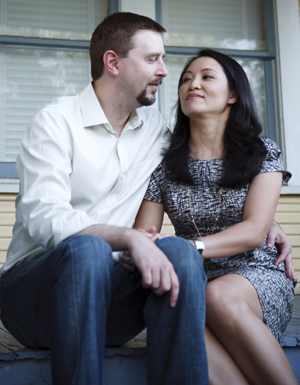By Hope Yen
The Associated Press

Married for 7 months, Hai Nguyen, 37, and Jon Pope, 37, sit outside their home in Houston, Tuesday, May 25, 2010. They are part of a slowing trend of inter-ethnic marriage. (Photo by Michael Stravato/AP)
WASHINGTON (AP) — Melting pot or racial divide? The growth of interracial marriages is slowing among U.S.-born Hispanics and Asians. Still, blacks are substantially more likely than before to marry whites.
The number of interracial marriages in the United States has risen 20 percent since 2000 to about 4.5 million, according to the latest census figures. While still growing, that number is a marked drop-off from the 65 percent increase between 1990 and 2000.
About 8 percent of U.S. marriages are mixed-race, up from 7 percent in 2000.
The latest trend belies notions of the United States as a post-racial, assimilated society. Demographers cite a steady flow of recent immigration that has given Hispanics and Asians more ethnically similar partners to choose from while creating some social distance from whites due to cultural and language differences.
White wariness toward a rapidly growing U.S. minority population may also be contributing to racial divisions, experts said.
“Racial boundaries are not going to disappear anytime soon,” said Daniel Lichter, a professor of sociology and public policy at Cornell University. He noted the increase in anti-immigrant sentiment in the United States after the Sept. 11 terror attacks as well as current tensions in Arizona over its new immigration law.
“With a white backlash toward immigrant groups, some immigrants are more likely to turn inward to each other for support,” Lichter said.
Broken down by race, about 40 percent of U.S.-born Asians now marry whites — a figure unchanged since 1980. Their likelihood of marrying foreign-born Asians, meanwhile, multiplied 3 times for men and 5 times for women, to roughly 20 percent.
Among U.S.-born Hispanics, marriages with whites increased modestly from roughly 30 percent to 38 percent over the past three decades. But when it came to marriages with foreign-born Hispanics, the share doubled — to 12.5 percent for men, and 17.1 percent for women.
The numbers reflect in part the internal struggle that Asians and Hispanics say they feel navigating two cultural worlds — the U.S. and their parents’ homeland.
Hai Nguyen, 37, of Houston recalls the instant connection she felt after meeting her first Vietnamese boyfriend, Greg, in college. Nguyen says while she had to explain herself to white boyfriends, with Greg, it was a feeling that “he so gets me, because we eat the same food, we like the same things, our families know each other, and there is so little that needs to be said.”
With the enthusiastic support of her parents, she and Greg married. But their connection soon began to fade, due partly to Nguyen’s budding career as a business analyst, which clashed with more traditional expectations for her to “always have fresh food on the table.” The two divorced and Nguyen is now remarried to Jon, who is white.
“My parents have prejudices, but they’ve accepted it,” said Nguyen. She described occasionally feeling different with her parents and other single-race couples. “They know it’s inevitable. My native tongue will eventually fade, and history will take its course.” ♦



